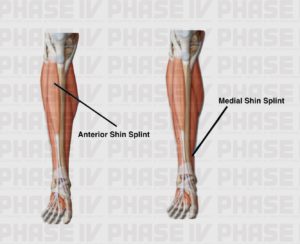Shin Splints: Anatomy and Function
By CEO Robert Forster, PT
An excerpt from Healthy Running Step by Step
Anterior shin splints appear as pain in the fleshy muscle in the front of the lower leg. Although this injury is common when runners first begin running after a layoff, it is rarely serious or persistent.
When you move your body forward over a weight- bearing foot, the toes are extended and lifted upward, winding the plantar fascia taut like a skin over a drum. This action helps transform the foot from a flexible structure able to adapt to variations in the walking surface, to a rigid lever that supports the foot while it’s on the ground, by limiting the degree that the arch collapses as the body moves forward over the foot.
A quick anatomy lesson may help explain what’s happening here: Muscles deep in the back of the calf function to slow down the forward progression of the tibia over the foot in the stance phase of running. The tendons of these deep flexor muscles attach either directly to the medial border of the tibia or indirectly by way of tether-like structures. When they fatigue they begin to function poorly, the tendons become in inflamed (tendonitis), and they pull the periosteum covering away from the bone and create acute pain (periostitis).
How You Feel the Pain
Typically, shin-splint pain will first appear at the end of long runs or after extended efforts. Soon, the pain will appear earlier in the workout and sometimes abate as you warm up, only to return toward the end of the workout. As time goes on, the pain will spill over into walking and standing during activities of daily living. Occasionally, runners will pull up (stop due to pain) during workouts and racing with a complete fracture of the tibia.
How the Injury Happens
However, the single most important factor for the resolution of this injury and to prevent re-injury is to increase your running cadence (i.e., increase the number of steps you take per minute).
More steps per minute reduce the amount of time the muscles in the calf have to work each step and limit their load by limiting the degree of pronation. In addition, a light self-grip wrap around the shin bone will provide a compression force to help the periosteum re-adhere to the tibia bone.
If the pain is bilateral (i.e., in both legs), then the causative factors in the development of the shin splints are both overpronation and over-striding. If the pain is unilateral, then it is likely the painful side is the long leg, which is over-pronating in an effort to even out your leg lengths during weight bearing. This will have to be corrected to resolve the shin splint along with an increase in running cadence.
Summary
If you are running the marathon, your shin splints need to be evaluated immediately. Local icing and PT treatment at the painful site will help, but ultimately we need to address cadence, mechanics, and leg length discrepancy for total resolution of the problem. We will fix your injury and teach you prescription stretching and strengthen exercises to correct your alignment and work with you to prevent shin splints.
Call Forster Physical Therapy for your free evaluation: 310-656-8600
Remember, California law allows you to go directly to Forster PT without first seeing a doctor for a referral.









